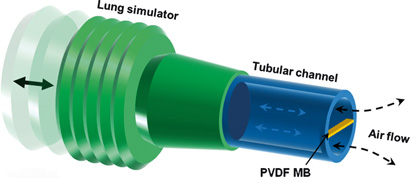
Breathe in, Breathe out, charge your implant. It sounds like a dream, but researchers at the University of Wisconsin-Madison report that the simple act of human breath can create enough energy to power a small biomedical device.
Currently, the devices that keep us alive – at least the ones that we can carry around with us – run on batteries. And while batteries work well for cell phones, toys, and cars, their inherent limitations create problems in the human body. Most critically, batteries are not forever. Recharge and replacement become risky when a battery is buried deep inside a body. Every hole in the skin is a possible site of infection. And batteries tend to be large and heavy. While size may not a big problem in a car engine, a battery in a brain, or a vein, or an infant needs to be very small.
One solution is to build an implant that can gather its own energy. Rather than keeping a semi-permanent energy supply packed away in a battery, a device could, in theory, use energy that is available around it. In a vein this could be the flow and collisions of blood cells, in a foot it could be compression from the ground, and in a nose or throat, it could be the movement of air.
On the surface this might smack a little of the centuries-old quest for “free energy.” But this energy is not “free;” it’s simply converted, like most all the energy we use, from another form. Dr. Wang’s implant is based on a phenomenon called “piezoelectricity.” Piezoelectric materials have the remarkable ability to convert mechanical stresses into electric charges. The trick has been turning these electric charges into enough usable current to power something that is actually useful. Researchers have understood the concept of piezoelectricity since the 19th century, but problems with power output and high cost has limited use. In the realm of the very small, however, piezoelectric materials are finding uses that no other material or device can fulfill, and smaller power needs make their application more feasible. Researchers can also carefully engineer such small devices to deliver exactly the right power dose.
Xudong Wang and his team have created a device that uses the force of air flow from human breath to create an electric current strong enough – and stable enough – to power a small device. The team uses PVDF (or polyvinylidene fluoride), a piezoelectric polymer material. The researchers chose PVDF because it is both flexible and biocompatible. Set like a thin bridge over two larger posts, the polymer oscillates when a small puff of air rushes past. Carefully designed electronics attached to the polymer bridge convert the resulting electric charge into usable electric energy – enough to power a glucose monitor, or a pacemaker battery.
(Check out this video to see the device in action.)
The publication of Dr. Wang and his collaborators’ work in Energy and Environmental Science produced a few news articles describing the paper. But since (disclaimer) I was at one time a colleague of Dr. Wang, I decided to ask him a few more probing questions as to how the work came about.
JM:Why didn’t you just make tiny windmills?
XW:The concept is to have minimum influence on the air flow pattern. The belt configuration has the potential to be made very small. To fabricate a micro-sized windmill is much more complicated.
Why did you use the material you did? Aren’t there other piezoelectric materials?
It’s a polymer. Flexible. Biocompatible. And it has the potential for large-scale roll-to-roll manufacturing. Other piezoelectric materials are mostly ceramics. They typically cannot sustain large and constant strain. Some of them are not biocompatible.
Why are there not more devices that use the piezoelectric effect as yours does?
There are commercial devices using this material, but in larger sizes. To make a very thin PVDF film is a challenge that we overcame. In order to have a belt to oscillate under low-speed air flow, we have to make belt very thin and with large thickness-length ratio.
What was your biggest technical hurdle?
The greatest difficulty was making the belt very thin while keeping its good piezoelectric property. We used ion beam etch to reduce the thickness of commercial PVDF thick films.
Why is it difficult to get the size of the belt just right?
Making piezoelectric beta-phase PVDF into a very thin film is challenging because forming beta-phase PVDF requires large stress. A thin film cannot sustain the stress required for forming beta-phase. Therefore, we cannot use conventional approaches to make piezoelectric PVDF thin film with the desired small thickness.
How could your device be improved?
We need to improve the surface smoothness and thickness uniformity.
Could we really stick this in a person and use it to power something?
I hope so. Our work just demonstrated the possibility of harvesting energy from human respiration. We used a biocompatible material and lowered the cut-in air flow speed to satisfy the air-flow speed of respiration. Whether it can really be used in a person will depend on a reasonable design.
Would this device make it difficult to breathe? Would it be uncomfortable?
This is one reason that we used a belt instead of a small windmill. The belt will have the least influence on the flow pattern. Putting this belt inside a person will be like adding a few more “hairs” inside the nose, I think.
Would talking or singing mess it up?
Talking or singing will produce much higher air flow rate compared to normal breath. This might be an issue. Higher oscillation amplitude might destroy the belt. I think it may be necessary to integrate something like “high flow rate protection” if it is really used inside a person.





Comments